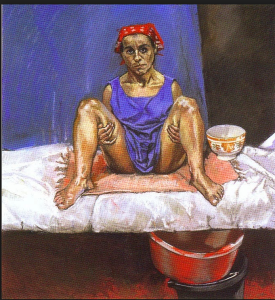by Sonia Corrêa
When, in 1998, the proposal to legalize abortion in Portugal was defeated in a first referendum, the acclaimed painter Paula Rego produced a blasting series of ten pastels that portray women undergoing abortions. In interviews with the Portuguese press, when the series was exhibited, Paula Rego said that the series was inspired by both her own abortion experiences and what she has witnessed as the experience of poor women who lived in the villages around the area of Ericeira, where she has grown up.In commenting the series Rego said: “Naturalism is very out of fashion, but I do not care. These silent paintings with their grave answers will resist”.
We have chosen to Rego’s Abortion Pastels in August, 2016 because Brazil — or to be more specific the Metropolitan Area of Rio de Janeiro — has once again become a stage of women’s carnage that results from unsafe and illegal abortion. On August 24th the press reported that Caroline de Souza Carneiro, 28 years old, has died of a clandestine, unsafe botched abortion. Her corpse left over in the street repeated the cruel pattern of abjection that has also characterized the deaths of Jandira and Elisângela em 2014 (check here).
Once again, we call attention to Paula Rego’s work to mark September 28th, the International Day of Struggle for Legal and Safe Abortion.
Paula Cristina Figueiredo Cabral and Sonia Cristina Rodrigues Ildefonso in the article O sexual e o politico no trabalho de Paula Rego (The sexual and the political in Paula Rego’ work) observe that these are the first Rego’s paintings that are not titled. Rather they have been named “Untitled”, a resource quite frequently used by abstract painters, which, however, causes great discomfort in the case of the figurations portrayed in the series. As noted by Cabral and Ildefonso:
[It] makes more disturbing and challenging for the observer to conjure what can not be named, to designate ‘something’ that society prefers not to recognize and face. The law of secrecy around the taboo topic of abortion, a practice that hypocritical societies continue to condemn to the underground, as a shame and as crime— is what these images reveal and denounce and it is quite certainly that this was the first time that the issue was addressed in [those terms] in painting.
The authors also correctly underline that the women portrayed in the pastel may be suffering, but they are neither passive or victims. Their eyes defy interrogate their viewers, transferring to them the responsibility and guilt for what they are undergoing. The brutal realism and disturbing, albeit painful, strength of the ‘abortion pastels ‘ is not, however, specific to the topic. This is how Paula Rego paints: huge screens, strong colors, very troubling creatures and human relations. In the introduction of her book Paula Rego’s Maps of Memory: Sexual and National Politics, Maria Manuel Lisboa grasps the troubling grips of the painter’s vocabulary and narratives in the following terms:
I would argue that her honesty, recklessness and refusal, all tend towards the same objective: namely the desacralization of a series of received expectations and assumptions, whether moral psychological or national, hinging on definitions of childishness, innocence and purity that she vandalizes and exposes as illusory. She exposes guilt endemic to the appearance of respectability… In doing so, however, she deliberately renders problematic standard and seemingly straightforward definitions of good and evil, weakness and strength, victimization and oppression.
Rego ‘s paintings are widely known and appraised in Portugal and the in UK, which is her “other” home, as since a teen-ager, she has been commuting between the two countries. But Rego is not really as much known as she should be beyond these boundaries. Even in Brazil, despite the cultural proximity with Portugal, it was just after a retrospective at the São Paulo Pinacoteca, in 2011, that her work became more accessible, appraised and discussed and, in particular, images of the ‘abortion paintings’ began circulating in power-point presentations and social network posting.
It should be also mentioned that critical feminist academic production on Paula Rego’s pictorial universe remains relatively scarce even in Portugal. And, as far as I could verify, it is inexistent in Brazil. The literature in English is not voluminous either. Lisboa’s book above mentioned is therefore a rare jewel. Another key reference is the RHM 2004 article by Agnette Strøm, Untitled: The Abortion Pastels: Paula Rego’s Serie’s on Abortion. This scarcity is rather surprising because Rego’s work addresses politics through the tragedies, cruelties and deep ambivalences of the domestic world, constantly evoking the specters and traces of the Salazar era authoritarianism. I found Paula Rego, accidentally, in a trip to Lisbon, in 2008, when alone in a friends’ house I spend hours, flabbergasted, gazing at the women’s masculine bodies under archetypical female clothes, the complexity and violence of gender and human relations, cruelty, hypocritical piety and the tropes of nationality, religious and political conservatism that she paints. It is our expectation, as SPW, that as more feminist and sexuality scholars get to know Rego’s magnificent work few may be inspired to write about her.

